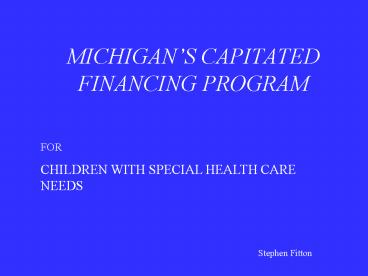MICHIGANS CAPITATED FINANCING PROGRAM - PowerPoint PPT Presentation
1 / 26
Title:
MICHIGANS CAPITATED FINANCING PROGRAM
Description:
Attract organizations with interest and specialization in CSHCN. Tailor standards and financing to CSHCN. Disease management principles ... – PowerPoint PPT presentation
Number of Views:34
Avg rating:3.0/5.0
Title: MICHIGANS CAPITATED FINANCING PROGRAM
1
MICHIGANS CAPITATED FINANCING PROGRAM
FOR CHILDREN WITH SPECIAL HEALTH CARE NEEDS
Stephen Fitton
2
CHOICE OF BROAD STRATEGY
- Advantages of Separate Initiative
- Focus on CSHCN specifically/not competing
- Attract organizations with interest and
specialization in CSHCN - Tailor standards and financing to CSHCN
- Disease management principles
3
Disadvantages
- Family members in different health plans
- Does not push managed care industry to respond to
special needs children
4
MICHIGANS CSHCN (Title V) PROGRAM
CHARACTERISTICS
- Long history as independent program
- Strong advocacy base (families and advocates)
- Unique relationship with state Medicaid program
- Large program
- gt20,000 Active children
- gt100 million budget
5
MCH and RWJ Grants
- Provided focus
- Provided resources
- Provided expertise
- Medicaid Working Group
- Rick Kronick
6
FINANCING PRINCIPLES
- I. Partial Risk, Not Full Risk
- Create an incentive toward efficient care with
some reward - Protection for plans and state given the state of
the art of capitated rate-setting for high risk
populations
7
II. No Discounting
- Rates set at 100 of Fee-For-Service
- Budgetary objectives were to improve
predictability of expenditures and future growth
rather than short term savings
8
III. Fair Method of Payment
- Analysis to identify key predictive variables
- Develop risk adjustment methodology using those
variables
9
Initial Assumptions
- Build in reinsurance (stop-loss) at 90 above
100,000 - Develop overall risk-sharing on profits and
losses - Incorporate diagnosis as risk adjuster
10
Rate-Setting is Data Dependent
- MA eligibility file
- MA Eligibility
- Insurance Status
- Age
- Gender
- County
- Program Category
- Scope
- Coverage
- Level of Care
- CSHCS Eligibility File
- Title 5 Eligibility
- Primary Eligibility Diagnosis
- Insurance Status
- Age
11
Claims Data
- Extract of automated claims for any child
eligible for CSHCS at any time during 1994 or
1995 - Fully adjusted claims paid
12
Risk Adjustersor How to Divide the Rate Base
into Rate Cells
- Approach Adopted for CSHCS
- Medicaid
- Private Health Insurance
- Primary Enrollment Diagnosis or Age or Hourly
In-Home Services - Region(Geographic)
- Traditional Medicaid Approach
- Program(AFDC vs. Disabled)
- Age
- Gender
- Region
13
(No Transcript)
14
Computation of Final Rates
- Followed standard Medicaid rate setting
methodology - Start with raw rates from claims
- Apply various adjusters and factors
- i.e. incurring factor (IBNR)
- hospital capital costs
- third party recoveries
- administration costs
- trend factors (inflation)
15
Rate Add-On for Immunizationsand Well Child
Visits
- Itemization of Services
- Comprehensive according to accepted periodicity
schedules - Pricing
- Used Medicaid rates
- Immunizations reflect only the costs of
administration
16
Modifying Full Risk
- Reinsurance - Individual Recipient
- Risk Sharing - Total QHP Enrollment
17
Reinsurance
- State pays for 90 of covered expenditures above
100,000 per year for an individual child - 100,000 threshold prorated for children with
fewer than 12 months of enrollment
- For children enrolled for fewer than 12 months,
threshold is 100,000 multiplied by (M/12) where
M is the number of months enrolled. Minimum
threshold of 50,000 for children with 6 or fewer
months of enrollment.
18
Risk Sharing
- State proposes to share in individual QHPs
profit or loss - Four risk corridors are defined using the
following ratio - Total allowable expenses ? Total capitated
payments
19
- Risk Sharing (cont.)
- Total allowable expenses include all allowable
medical expenses and all administrative expenses
up to 10 of the total capitated payments - Case management is defined as allowable medical
expense up to 5 of total capitated payments
20
- Proposed Risk Corridors
- Between 85 and 105 - Full risk for QHP
- Between 105 and 120 - QHP and DCH share losses
equally - Above 120 - DCH absorbs 90 of losses and QHP
absorbs 10 of loss - Less than 85 - DCH retains savings
21
Rate Discussions with Health Plans
- A p p r e h e n s i o n
- and
- C a u t i o n
22
Major Concerns of Plans
- Start-up costs (investment)
- Low enrollments associated with voluntary choice
by consumers - Cost limits on administration and case management
- Adverse selection even within risk adjustment
structure
23
Major concerns of Health Plans (cont.)
- Ability to achieve significant savings on medical
care costs - Ability to get providers to accept risk or
Medicaid rates
24
Major Changes Negotiated in Final Contract
- Five year contract period
- Change risk corridors so that state holds more
risk - Guarantee revised risk corridors for 3 years
- Add 3 - 1 performance incentives
- Agreed to a rigorous risk selection study with
attached financial commitment - Updated rates to 1998 levels with new trend
factors (10 increase)
25
Negotiated Risk Corridors
- Less than 85 of the total capitated payments
- DCH retains 100 of savings
- Greater than 85 and less than 92 of total
capitated payments - Contractor and Department share profits on 50/50
basis, i.e., they both assume 50 of the risk - More than 92 and less than 103 of total
capitated payments - Contractor at full risk, i.e., profits or losses
are 100 in this range
26
- Risk Corridors (cont.)
- Greater than 103 or less than 110 of total
capitated payments - Contractor and Department share losses on 50/50
basis, i.e., they both assume 50 of the risk - Greater than 110 of total capitated payments
- Department assumes 90 of these excess costs
while the contractor retains 10 responsibility































